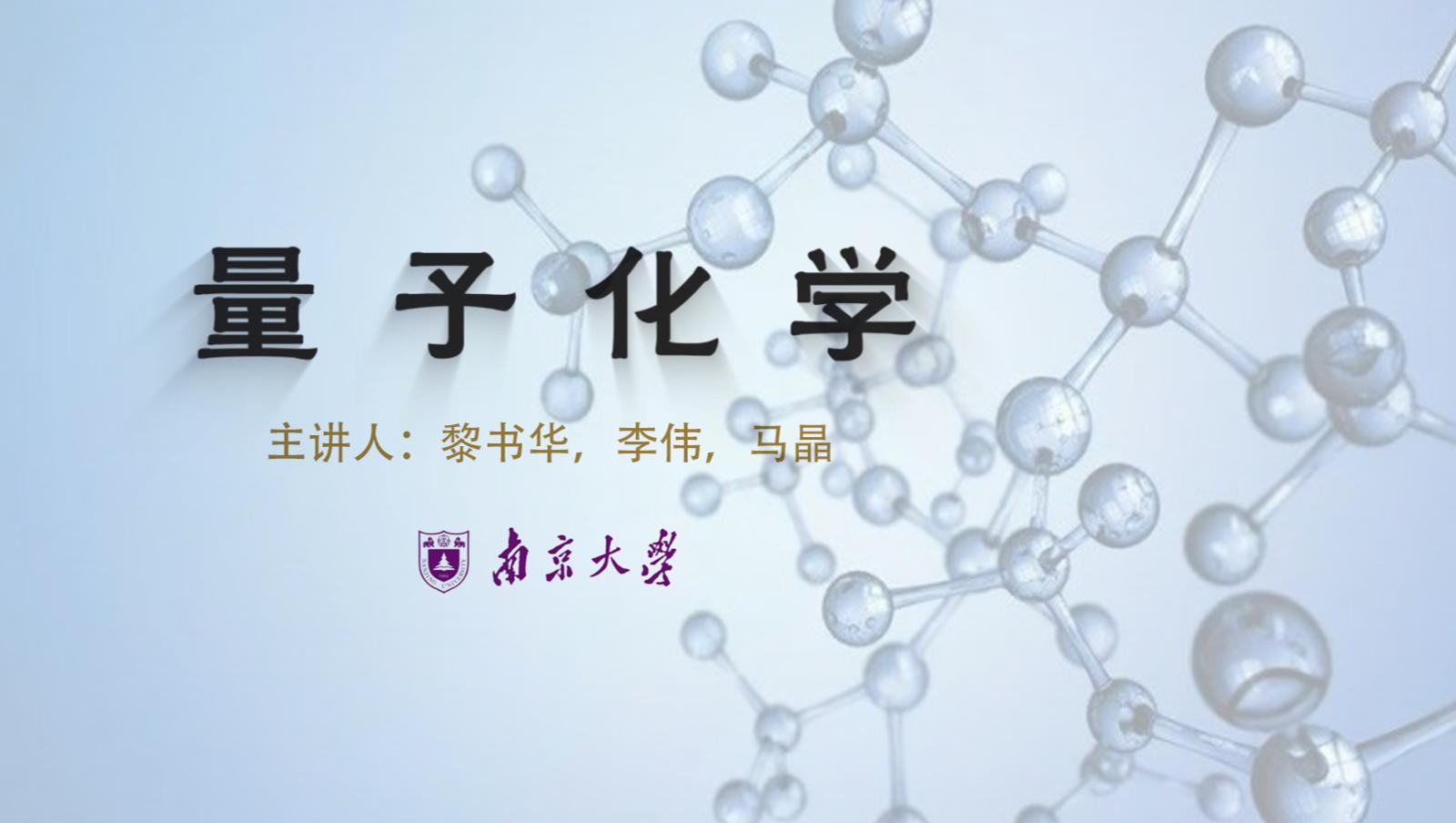量子化学是应用量子力学来研究化学问题的学科。量子化学计算方法在化学及其相关领域的研究中发挥了至关重要的作用。使用量子化学,可以计算预测分子的性质,如几何结构、偶极矩、核磁共振谱、振动频率及其吸收与发射光谱等;预测化学反应的过渡态和中间体,并考察反应机理;研究分子间作用力和溶液等凝聚相体系的结构和性质;计算宏观体系的热力学参数(如熵和热容等)。如今,量子化学已经在化学的所有分支学科中被广泛应用。因此,学习量子化学对于在原子和分子层次理解化学现象的本质、推进化学学科的发展均有重要意义。
《量子化学》课程主要面向一年级研究生或高年级本科生,目的是为研究生或高年级本科生在原子、电子水平上理解分子结构和性质、化学反应机制打下理论基础。该课程从量子力学的概念和基础知识出发,由浅入深,逐步过渡到量子化学的基本理论及算法,以及量子化学的计算应用。课程既注重体系和知识结构的完整性,又针对重点、难点给出了较为详细的理论推导,并介绍了当前该领域的一些前沿和热点研究。
本课程共分八章,内容涵盖:量子力学的诞生及发展历史;量子力学的基本假设和原理;简单体系的精确能量和波函数;氢原子的能量和波函数;近似量子力学方法;多电子原子的结构和光谱;分子的化学键理论;计算量子化学方法和应用研究。
Chapter 1 The Dawn of the Quantum Theory
1.1 Blackbody Radiation and Photoelectric Effect
1.2 Hydrogen Atomic Spectrum and Bohr Theory
1.3 de Broglie Wave and Heisenberg Uncertainty Principle
第一次线上答疑课
Test 1 The Dawn of the Quantum Theory
Exercise 1 The Dawn of the Quantum Theory
Chapter 2 The Postulates and General Principles of Quantum Mechanics
2.1 Wave Functions, Operators and Eigenvalues
2.2 Commutator and Hermitian Operator
2.3 Eigenfunctions of Commutative Operators
2.4 Orthonormal Set
2.5 Time-Dependent Schrödinger Equation
第二次线上答疑课
第三次线上答疑课
Exercise 2 The Postulates and General Principles of Quantum Mechanics
Test 2 The Postulates and General Principles of Quantum Mechanics
Chapter 3 Exact Energies and Wave Functions for Simple Systems
3.1 A particle in a 1-D Box
3.2 Applications and Extensions of a Particle in a Box
3.3 Rigid Rotator and Rotational Spectroscopy of Diatomic Molecules
3.4 Harmonic Oscillator
3.5 Infrared Spectrum of Diatomic Molecules
第四次线上讨论课
第五次线上讨论课
量子化学习题课+答疑
Exercise 3 Exact Energies and Wave Functions for Simple Systems
Test 3 Exact Energies and Wave Functions for Simple Systems
Chapter 4 The Hydrogen Atom
第六次线上讨论课
4.1 Schrödinger Equation for the Hydrogen Atom
4.2 s Orbitals are Spherically Symmetric
4.3 p Orbitals and the Zeeman Effect
4.4 Spin Angular Momentum and Spin-Orbit Interaction
4.5 Term Symbols of a Hydrogen Atom and Spectrum of Atomic Hydrogen in an External Magnetic Field
角动量补充
Test 4 The Hydrogen Atom
Chapter 5 Approximate Methods
5.1 Variational Method
5.2 Linear Variational Principle and Secular Determinant
5.3 Perturbation Theory and its Applications
第七次线上讨论课
Test 5 Approximate Methods
Exercise 5 Approximate Methods
Chapter 6 Many‒Electron Atoms
6.1 Atomic Units and Hamiltonian Operator of a Helium Atom
6.2 Antisymmetric Wave Functions can be Represented by Slater Determinants
6.3 The Hartree-Fock Method
6.4 Hartree‒Fock‒Roothaan Atomic Orbitals are Available On‒Line
6.5 Correlation Energy is the Difference Between Hartree‒Fock Energy and Exact Energy
6.6 Term Symbols
6.7 Atomic Spectra and Spin‒Orbital Effect
第八次线上讨论课
Test 6 Many‒Electron Atoms
Exercise 6 Many‒Electron Atoms
Chapter 7 Theory of Chemical Bonding in Molecules
7.1 Born-Oppenheimer Approximation and H2+
7.2 A Simple Molecular-Orbital Theory for H2\n7.3 Hartree‒Fock‒Roothaan Equations Give the Optimum Molecular Orbitals
7.4 Molecular Orbitals for Homonuclear Diatomic Molecules\n7.5 Molecular-Orbitals for Heteronuclear Diatomic Molecules
7.6 Molecular Term Symbols
7.7 Hybrid Orbitals are Useful for Understanding Molecular Shape of Polyatomic Molecules
7.8 Applications of Hartree-Fock Method to Polyatomic Molecules
7.9 Hückel MO Theory for Conjugated Hydrocarbons
7.10 Advances in Valence Bond Theory
线上讨论课
Exercise 7 Theory of Chemical Bonding in Molecules
Test 7 Theory of Chemical Bonding in Molecules
Chapter 8 Computational Quantum Chemistry
8.1 Gaussian Basis Sets
8.2 Hartree-Fock Method and its Applications
8.3 Advanced Quantum Chemistry Methods
8.4 Ab Initio Program and Applications : Software and Hardware
8.5 Ab Initio Program and Applications: Calculation of Thermochemistry Parameters
8.6 Ab Initio Program and Applications: Calculation of Potential Energy Surface and Reaction Mechanism
线上讨论课
Test 8 Computational Quantum Chemistry


